Kommos Building P
Text (Chapter 5 – Conclusions pgs. 850-853) and illustrations (frontispiece & pgs. 957, 962, 1000) Excerpts from Kommos V (Copyright 2006)
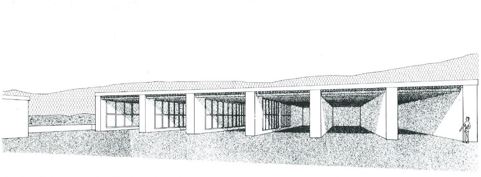
With slabs and ashlar blocks from (earlier building) T’s walls, many of which were razed in the process, a new building, P, was constructed in LM IIIA2 (1300 BC) on T’s East Wing (Chap. 1.4). P was apparently built in stages, beginning with P1 and P2, over a number of generations, that continued into LM IIIB, when the building was completed (see Rutter, Chap. 3.3).11 P was almost square, being about 38.51 m east-west by 39.60 m north-south. It consisted of six broad spaces, which we have called “galleries,” oriented east-west and facing west toward the shore. According to our estimates, most of T’s West Wing (except for less exposed parts of T5) had already been destroyed by the sea, perhaps even partly quarried by the builders of P1-P2 and Building N, so the way to and from the shore was now open. The galleries, as far as one can tell (the central and eastern parts of Galleries 4–6 have not been excavated) averaged 5.44 m in width, although the sixth one, the last to the south, was narrower (4.43 m) (Pl. 1.68).
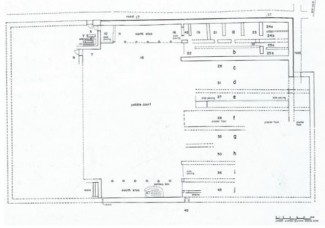
As documented in Chap. 1.3, P’s floors were uniformly of earth rather than being floored with slabs or occasionally plastered, as T’s had been. These earthen floors, with evidence for multiple renewals, are characterized by burning—some had hearths, and at least one had ovens set into the floors in LM IIIB (Pl. 1.98). Characteristic of the pottery, invariably in fragments, are the ubiquitous short-necked amphoras, often stained by hematite on their interiors, a form of vessel introduced at Kommos in LM IIIA2. As Rutter has suggested in detail (Chap. 3.3 and 2000), at least part of the explanation of P’s function(s) lies in the use of these transport amphoras. Their identification at other Cretan sites (now minimal) and abroad (an ongoing project) would certainly enhance further interpretation.
Concerning the primary use of these galleries, the detailed argument has already been made that they were shipsheds that housed ships during the winter, nonsailing months.12 That argument has been based on a number of grounds: (1) The form of the galleries, long and broad, suggests storage, as shown by analogies within Minoan as well as other Mediterranean cultures.13 (2) The unprecedented breadth and length of the galleries, as compared with other Minoan storage facilities (e.g., the West Magazines at Knossos or those in the East Wing of the Malia Palace, both about 2 m wide, and both designed for pithos storage), must be explained.
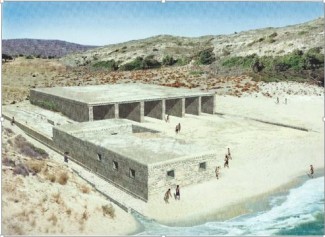
This size, combined with the lack of pithos fragments in P, suggests that P’s storage functions were unusual in the present Minoan archaeological record.3 The lack of closure with doors and walls, pillars, or columns in five of the six galleries (with the exception of the sixth, discussed above, with its later blocking/retaining wall [Pl. 1.110] and the mound of the LM IA kiln [Pl. 1.125] in front of its entrance) suggests that whatever was stored was accessible but not easily portable.4
P was next to the shoreline at a known harbor town.5 Similar, but rock-cut, installations are near Nirou Khani, presumably of BA date (J. W. Shaw 1990; J. W. Shaw and M. C. Shaw 1999 offer comparative documentation).6 Finally, the closest well-known parallel to such an architectural form is the Classical Greek shipshed built to house military vessels (triremes).11 The P galleries are comparable to these Classical neosoikoi in size and proportion; also, the galleries are parallel to one another and face the sea. The major difference is that the seaward ends of the Greek examples were set slanting down into the water so that the ships could be drawn up and then, when the time came, launched more easily. This was possible because, partly for military considerations, the Greeks often chose naturally sheltered harbors that could be partially enclosed by fortification walls, with towers at a harbor entrance that could be linked by chains.
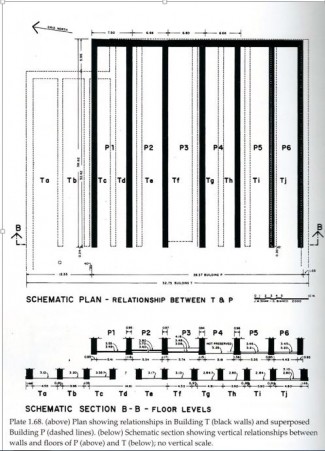
During the Aegean BA, however, open shorelines, often in combination with a small offshore islet, were chosen as harbor sites, so any buildings along the shore might be exposed to almost the full force of waves driving onshore. Since Minoan building technique had not reached the point at which jetties and quays could be built, all structures near the sea would by necessity have had to be situated some distance back from the highest onshore wave reach, which, in the case of Building P, was not far west of the western edge of the former Central Court of Building T (Pl. 1.4). That ships would actually be drawn up on the shore is shown in the miniature fresco from Akrotiri on Thera (Marinatos 1974, col. pl. 9) as well as in a passage in the Iliad (ll. 1. 485–86):
But when they had come back to the wide camp of the Achaians they hauled the black ship up on the mainland, high up on the sand, and underneath her they fixed the long props.15
Published reception of the proposed identification of P as shipsheds has generally been positive (e.g., Warren 2000a: 24 [“probable”]). On the basis of plan and location, colleagues have recently identified Hawes’s
“Shore House” at Gournia as performing a shipshed function.16 Moreover, Doumas has concurred (pers. comm.) with M. C. Shaw’s identification of the possible shipshed in the LM IA fresco from the West House at Thera (M. C. Shaw 1985: 23, pl. IIIb). As argued by Georgiou (1993: 360), a BA ship emptied of cargo and ballast could surely be dragged up on shore. This would happen only once a year, with the help of log rollers on which the ships could also slide, with numerous people pulling ropes to drag the ships, and with some props to keep the ship level. As proposed by Gifford (1995: 76–81), local relative sea level in the Kommos area has continued to rise, so that at its present level P’s floor is at +3.30 m.
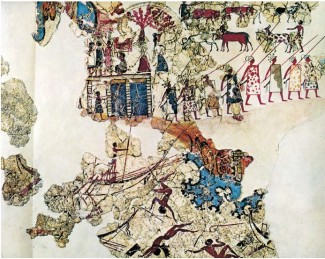
During the time that P was used, with an approximate difference of 2–3 m in sea level between now and then, the same floor level was at +5.30–6.30 m. This means that the building was not threatened by the waves, which would have reached then not much higher than +4.00 m. The distance from P to the shoreline was about 130 m, calculated as the distance from it to the present shoreline (80 m) plus the 30 to 50 m to be added for the ancient shoreline that was farther out.
The preceding proposal for P is based, as has been seen, on architectural form and relative size, location, and analogy. It remains to be proved, however, by definitive discovery of sufficient nautical equipment connected with such galleries. Also, at least at the moment, this type of building remains clearly defined only for the LM III period. Possibly, like megaron like LM IIIA2 Building ABCD at Aghia Triada, it will remain unique to the Postpalatial architectural resurgence in the western Mesara. However, the analogous building at Gournia, mentioned above, along with others still undiscovered, could extend the range back into Neopalatial times. One must also consider earlier iconography that may reflect actual building tradition, as in the LC IA miniature fresco from Thera, mentioned above, as well as the LC I frescoes from Kea (J. W. Shaw 1990: 422, fig. 2 for the latter).
In this connection it is worth introducing the issue of whether the potentially equally long but narrower rooms (C–J) of Neopalatial Building T (Chap. 1.2) were the predecessors of P either in shape or function, or in both.17 An argument that they were could be based on the fact that in these only partially excavated rooms there is so far no evidence that cross walls interrupt their length, aside from possible small rooms at the back, on the east. Also, aside from Room J in Gallery P6 (a wooden frame [?] set into the sides of two opposed pillars),18 there is little clear sign of closure along the east side of the court. An argument that the rooms are not analogous with P, and therefore functioned otherwise, can be based on the significantly greater width of P’s galleries and the obvious differences in floor material (slabpaved areas and, especially, delicately plastered floors that would seem unsuitable for ship storage). Possibly a form used for one purpose in Building T was adapted through enlargement for another purpose in a succeeding structure (P). It is probably best to leave this question unanswered until further excavation at Kommos or elsewhere provides material affecting the argument.
Notes for the above extract of chapter 5
3. The form of the west “wings” of both buildings, now washed away by the sea, however, remains unknown.
4. Such platforms were often partly of thick mud-brick walls that underlay the walls projecting above ground level, as in Bietak 1996: fig. 56 (early New Kingdom palatial fortress at Avaris). At Early Bronze/ Middle Bronze Marki Alonia in Cyprus builders constructed a frame of walls that served as the bases for the main part of a building, and after the interior of the frame was filled with rubble and debris, the lighter walls were built on the level thus created (Frankel 1998:246).
5. In a deep sounding north of the east-west road and east of the Classical Round Building was a large pottery deposit dating to an early stage of MM IIB (contexts, 9, 10, 11, and 12 [Trench 20B] in Betancourt 1990, dated there to MM IIA; see Chap. 3.2) Being largely mendable and homogeneous in date, this pottery is very different in character from the largely unmendable, mixed MM IB-IIA-IIB Early pottery in the construction fills of Building AA, and cannot have been the source. Another consideration is the amount of kouskouras clay bedrock found in so many of the AA fillings. Some would, of course, be available from the bedding trenches excavated in the Southern Area for new walls, but certainly less than what was needed. It is doubtful that the clay was removed from the enclosed AA area, since the aim of the builders was to create a platform by elevating a preexisting slope. Could the clay have been excavated from a slope to the east, presently under meters of sand? It may have come from excavation for even further building (of houses?) north of the east-west road, an area where the Protopalatial levels are relatively unknown at this point.
6. Concerning upper floors in T, we believe there was one above T5, as indicated by the stairway there. The stairway in the south-west corner of the Central Court (Pl. 1.130) suggest that most of the largely missing West Wing had two storeys, and that the two stairways mentioned (rather than a third, leading up from the Central Court in the destroyed part of the West Wing) serviced that wing. Although an argument can be made that the two stoas (especially the South Stoa) had an upper floor, this remains unproved. There was probably not a second floor in the East Wing, where only one narrow stairway (in Room J, in Pl. 1.114) has been discovered; perhaps it provided access to the roof.
11. Rutter has pointed out recently that the latest pottery in fill below floors of Galleries P3-P6 is LMIIIA2 in date, whereas the earliest floor pottery associated with those gallery floors is of LM IIIB vintage. One explanation may be that the four southern galleries, although built in LM IIIA2, were not used until significantly later. It seems doubtful, however, that such enormous spaces, once constructed, were not used. More likely, given the ceramic evidence, is that all of Building P, perhaps including the floors, was laid out in LM IIIA2 but that the walls and roofs of the southern galleries were completed later, after P1 and P2 had already been in use. Such an explanation could also account for the numerous irregularities in construction seen there (e.g., in use of timbering, masonry, care in building) already pointed out in Chap. 1.3.
12. M.C. Shaw 1985, J.W. Shaw1986-22-69; J.W. Shaw and M.C. Shaw 1993; J.W. Shaw and M.C. Shaw 1999, also with references to possible ship sizes.
13. For a variety of them drawn at the same scale see J.W. Shaw 1986: fig. 11.
14. For detailed discussion of Greek shipsheds, see Blackman 1968.
16. Hawes et al. 1908: 19; Fotou 1993: 98 pls. XX- XXI. Watrous and, subsequently Rutter and Van de Moortel, have inspected the building, which is quite eroded where it is next to the sea and partly exposed on land. Of the three to four possible galleries, two are about 4 m wide. The building, oriented north towards the sea, was at least 15 m long, but boulders in the water suggest that another 10 m could be added to that length. Watrous reports (pers. Comm.) that LM IB pottery was found associated with it.
17. Dario Puglisi (2001b) has recently made the proposal, one that would certainly been recast had this volume been available to that author at the time, that Building T originally consisted of ten long galleries facing the sea, without stoas and without rooms to the west (e.g. T5). As has been shown here, T5 actually preceded the building of the rest of T, as did the original (AA) form of at least one of the two stoas. Thus Puglisi’s argument must be based on only eight of the galleries, the floor of one of which was plastered. Also, contra Puglisi, there is no evidence that the kiln in the South Stoa produced amphoras for trading abroad.
18. P6 was also closed on the west.

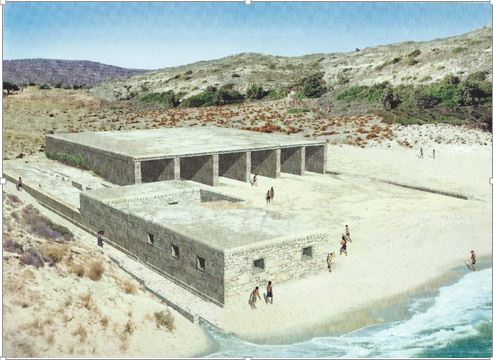
Leave a Reply
You must be logged in to post a comment.